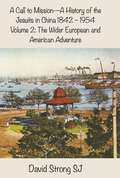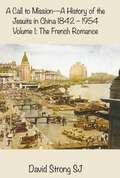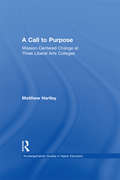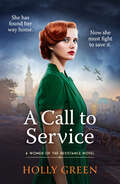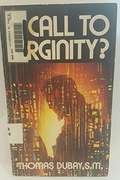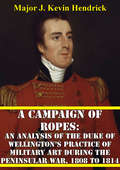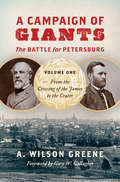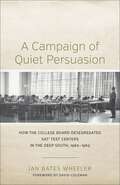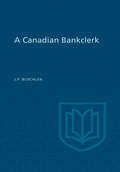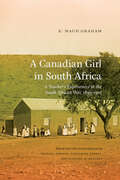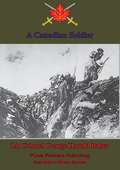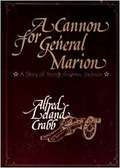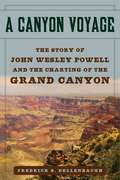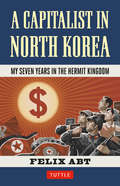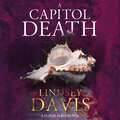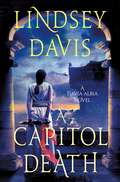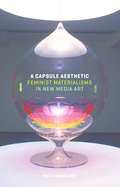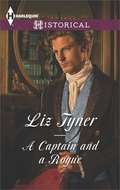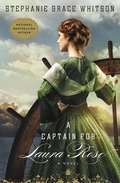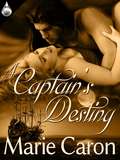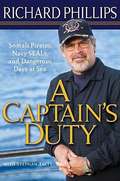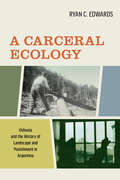- Table View
- List View
A Call to Mission - A History of the Jesuits in China 1842-1954: Volume 2: The Wider European and American Adventure
by David StrongChina has bulked large in the imagination of the Catholic Church for 500 years. It had been central to the missionary dream of the Jesuits for almost as long. However, only with this book's appearance has the detailed focus of attention shifted to the substantial and neglected period of catholic and Jesuit engagement with china - the almost 120 years from the second arrival of the Jesuits. Matteo Ricci the polymath, Ferdinand Verbeist and Adam Schall von Bell the astronomers and the exquisite painter who influenced Chinese painting beyond measure, Giuseppe Castiglione, have been written about, made ls of and been the heart and soul of the first stage of Jesuit impact on China - in the 17th and 18th Centuries. They brought Western learning and art to China and took Chinese language and literature to Europe. The Jesuits were the first multinational to be welcomed in China and they came with a specific method of engagement - to make friends build relationships and share their gifts before anything else was transacted, including conversations about Christianity. It remains an unsurpassed method of engagement with a rich and ancient people. But the second arrival - from the 1840's - was very different. It was made possible by the arrival of European governments and traders, many of whom came not just for financial gain but to spread their "superior" religion. This work by David Strong in two volumes is the first major treatment of the period from the arrival of the European and eventually American Jesuit missionaries under the protection of the so called Unequal Treaties through to their expulsion after the Communist victory in the long running civil war in 1949. Volume II- The Wider European Adventure- covers the commitments, places and activities of missions undertaken by the Spaniards, Austrian, Hungarians, Italians, French Canadians, and lastly in the 1930s, the Americans from California.
A Call to Mission - A History of the Jesuits in China 1842-1954: Volume I: The French Romance
by David StrongChina has bulked large in the imagination of the Catholic Church for 500 years. It had been central to the missionary dream of the Jesuits for almost as long. However, only with this book's appearance has the detailed focus of attention shifted to the substantial and neglected period of catholic and Jesuit engagement with china - the almost 120 years from the second arrival of the Jesuits. Matteo Ricci the polymath, Ferdinand Verbeist and Adam Schall von Bell the astronomers and the exquisite painter who influenced Chinese painting beyond measure, Giuseppe Castiglione, have been written about, made ls of and been the heart and soul of the first stage of Jesuit impact on China - in the 17th and 18th Centuries. They brought Western learning and art to China and took Chinese language and literature to Europe. The Jesuits were the first multinational to be welcomed in China and they came with a specific method of engagement - to make friends build relationships and share their gifts before anything else was transacted, including conversations about Christianity. It remains an unsurpassed method of engagement with a rich and ancient people. But the second arrival - from the 1840's - was very different. It was made possible by the arrival of European governments and traders, many of whom came not just for financial gain but to spread their "superior" religion. This work by David Strong in two volumes is the first major treatment of the period from the arrival of the European and eventually American Jesuit missionaries under the protection of the so called Unequal Treaties through to their expulsion after the Communist victory in the long running civil war in 1949. Volume 1: The French Romance - traces the people, projects, expansion and impact of those who provided the predominant Jesuit presence. At the height of it's engagement with China, the French Government has 19 Consulates and attendant military and navy throughout China. The French Jesuits were afforded access and protection by their government and activated missions in northern and central China - schools, seminaries, universities, parishes, retreat houses, publications - and attracted Chinese nationals to join their number.
A Call to Purpose: Mission-Centered Change at Three Liberal Arts Colleges (RoutledgeFalmer Studies in Higher Education)
by Matthew HartleyA decade ago, the majority of liberal arts colleges, suffering from a decline in resources, drifted from their traditional missions. This study looks at three insitutions and suggests that a clear mission is more than a common goal.
A Call to Service: An engrossing, powerful and heart-breaking WW2 novel (Women of the Resistance)
by Holly GreenHer country needs her. But her heart is elsewhere.After fleeing German-occupied Paris, Alix is back in her home in Belgrade, hoping to finally reunite with her parents. But while Alix has been fighting her own battles with the Resistance, her parents have too fled with King Peter to ensure his safety. As Alix decides to find her parents with her father's deputy steward, Drago, they are derailed and forced to reside in the Serbian country home.But all is not lost when Alix finds Nikola in the city - the man her father said she was to marry before war broke out. She finds she has more in common with him than ever expected, and together with Drago they join a new Resistance.But Alix hasn't forgotten about Steve, the handsome American pilot she fell in love with back in France, whom she last heard was harmed in battle. When a chance meeting brings Alix and Steve face to face once again, she must decide where her heart truly isFans of Suzanne Kelman and Fiona Valpy will love this captivating, globe-trotting, deeply rich historical fiction set in World War Two.Readers are loving A Call to Service:'A wonderful story of romance, adventure, and resistance. I can't wait to read the next book! I want more!' Reader Review'This was such a great historical book. I absolutely loved the story it was very well researched and the pacing was great!' Reader ReviewPraise for Holly Green:'So well written felt so real. Everything about it made for a great read. I recommend this and give it 5 stars.' Reader Review'A fantastic story The characters capture your attention right from the very first page.' Reader Review'The story had me hooked from the beginning highly recommend' Reader Review'Great book by this author felt like I was in the story' Reader Review'A brilliantly written and well researched book.' Reader Review'Holly's storytelling is amazing, you feel you are actually there.' Reader Review'Holly Green's research and delivery of her stories gives readers a glimpse of the reality of war.' Reader Review
A Call to Virginity?
by Fr. Thomas DubayThis book offers women a theologian's view of virginal dedication, as well as reasons for choosing this lifestyle, by presenting a positive view of virginity.
A Campaign Of Ropes: An Analysis Of The Duke Of Wellington’s Practice Of Military Art During The Peninsular War, 1808 To 1814
by Major J. Kevin HendrickThe purpose of this paper was to study the practice of military art at the operational level of war. The story of Wellington's ultimate success against Napoleon's Marshals was selected as a case study as it seemed rich in the application of mental agility to achieve an asymmetrical military advantage in a theater of war. As military theory recognizes two general types of military art, classical strategy and operational art, the research question was constructed to determine if Wellington practiced pure classic strategy, or an early/transitional form of operational art.In order to provide a basis of analysis, the essential elements of both classic strategy and operational art are next defined. The history of classic strategy is outlined, then the theory of Clausewitz and Jomini used to define its four basic elements. The practice of operational art is then traced, from its inception by U.S. Grant during the American Civil War, to Soviet operational theory developed in the 1920's. The theory of Dr. James Schneider, a primary interpreter of both Grant and the Soviets, provides the eight essential elements of operational art. To round out the section on military art, U.S. operational doctrine is outlined and discussed.Like most military officers, Wellington was a creature of his own experience, therefore a chapter is dedicated to the lessons he learned as a young officer in India. The following chapter is dedicated to a study of the Peninsular War. As the research question deals with both the operational and strategic levels of war, Wellington's tactics are neglected in favor of his campaign concepts and execution.
A Campaign of Giants--The Battle for Petersburg: Volume 1: From the Crossing of the James to the Crater (Civil War America)
by A. Wilson GreeneGrinding, bloody, and ultimately decisive, the Petersburg Campaign was the Civil War's longest and among its most complex. Ulysses S. Grant and Robert E. Lee squared off for more than nine months in their struggle for Petersburg, the key to the Confederate capital at Richmond. Featuring some of the war's most notorious battles, the campaign played out against a backdrop of political drama and crucial fighting elsewhere, with massive costs for soldiers and civilians alike. After failing to bull his way into Petersburg, Grant concentrated on isolating the city from its communications with the rest of the surviving Confederacy, stretching Lee's defenses to the breaking point. When Lee's desperate breakout attempt failed in March 1865, Grant launched his final offensives that forced the Confederates to abandon the city on April 2, 1865. A week later, Lee surrendered at Appomattox Court House.Here A. Wilson Greene opens his sweeping new three-volume history of the Petersburg Campaign, taking readers from Grant's crossing of the James in mid-June 1864 to the fateful Battle of the Crater on July 30. Full of fresh insights drawn from military, political, and social history, A Campaign of Giants is destined to be the definitive account of the campaign. With new perspectives on operational and tactical choices by commanders, the experiences of common soldiers and civilians, and the significant role of the United States Colored Troops in the fighting, this book offers essential reading for all those interested in the history of the Civil War.
A Campaign of Quiet Persuasion: How the College Board Desegregated SAT® Test Centers in the Deep South, 1960-1965 (Making the Modern South)
by David Coleman Jan Bates WheelerIn 1960, the College Entrance Examination Board became an unexpected participant in the movement to desegregate education in the South. Working with its partner, Educational Testing Services, the College Board quietly integrated its Scholastic Aptitude Test (SAT) centers throughout the Deep South. Traveling from state to state, taking one school district and even one school at a time, two College Board staff members, both native southerners, waged "a campaign of quiet persuasion" and succeeded, establishing a roster of desegregated test centers within segregated school districts while the historic battle for civil rights raged around them. In the context of the larger struggle for equal opportunities for southern black students, their work addressed a small but critical barrier to higher education.Shedding light on this remarkable story for the first time, Jan Bates Wheeler tells how the College Board staff members -- Ben Cameron and Ben Gibson -- succeeded. Their candid and thoughtfully written records of conversations and confrontations, untouched for nearly fifty years, reveal the persistence required to reach a goal many thought unachievable and even foolhardy. Indeed, their task placed them in the unusual position of advocating for school desegregation on a day-to-day basis as part of their jobs. This positioned Cameron and Gibson squarely in opposition to prevailing laws, customs, and attitudes -- an ill-advised stance for any nascent business venture, particularly one experiencing competition from a new, rival testing organization purported to accommodate openly those same laws, customs, and attitudes. Cameron and Gibson also accepted the personal danger involved in confrontations with racist school officials. The officials who cooperated with the pair assumed even greater risk, and in order to minimize that threat, Cameron and Gibson pledged not to publicize their efforts. Even years after their work had ended, the two men refused to write about their campaign for fear of compromising the people who had helped them. Their concerns, according to Wheeler, kept this remarkable story largely untold until now.
A Canadian Bankclerk
by Douglas Lochhead John Preston BuschlenThe story herein told is true to life; true, the greater part of it, to my own life. Also, I am convinced that my experience in A Canadian Bank was but mildly exciting as compared with that of many others. My object in publishing "Evan Nelson's" history is to enlighten the public concerning life behind the wicket and thus pave the way for the legitimate organization of bankclerks into a fraternal association, for their financial and social (including moral) betterment. Bank officials, I trust, will see to it that my misrepresentations are exposed. To mothers of bankclerks who attach overmuch importance to the gentility of their Boy's avocation; to fathers who think that because the bank is rich its employees must necessarily become so in time; to friends who criticize the bankclerks of their acquaintance for not settling down--this story is addressed. To the men of our banks who are dissatisfied with the business they have chosen, or someone else has chosen for them; to Old Country clerks who come out to Canada under the impression that Five Dollars is as good as One Pound; to bank employees in the United States, and to office men everywhere--I am telling my tale. Finally, I appeal to "the girls we have known." Be sure you study the subject thoroughly before accusing that inscrutable, proud and procrastinating clerk of yours of inconstancy. (From the Prologue)
A Canadian Girl in South Africa: A Teacher's Experiences in the South African War, 1899–1902 (Wayfarer)
by E. Maud GrahamA Canadian woman shares her story of traveling to South Africa to teach Boer children in concentration camps following the South African War.As the South African War reached its grueling end in 1902, colonial interests at the highest levels of the British Empire hand-picked teachers from across the Commonwealth to teach the thousands of Boer children living in concentration camps. Highly educated, hard working, and often opinionated, E. Maud Graham joined the Canadian contingent of forty teachers. Her eyewitness account reveals the complexity of relations and tensions at a controversial period in the histories of both Britain and South Africa. Graham presents a lively historical travel memoir, and the editors have provided rich political and historical context to her narrative in the Introduction and generous annotations. This is a rare primary source for experts in Colonial Studies, Women’s Studies, and Canadian, South African, and British Imperial History. Readers with an interest in the South African War will be intrigued by Graham’s observations on South African society at the end of the Victorian era.“A fascinating perspective on the country. . . . Graham’s account will help others understand how the British and English-speaking Canadians in South Africa perceived Boers and native southern Africans at the turn of the twentieth century, and her descriptions reveal details about everyday life in South Africa at an important moment of transition.... Graham’s book represents the perspective of a well-embedded outsider reporting to far-removed readers, rather than that of a female teacher involved in international or imperial education.” —Benjamin Bryce, Historical Studies in Education“Recommended for those who wish to learn more about South African history and early race relations or tensions. Graham’s opinionated writing will amuse and interest those researching women’s studies.” —Amy L. Crofford, African Studies Quarterly, Volume 16
A Canadian Soldier
by Lt. Colonel George Harold Baker M.P.Lt.-Col. Baker was born into a family with a long history of service to Canada: his father had served in the Provincial Legislature or the Dominion Parliament for over forty years. Colonel Baker, a man of many interests, undertook law at McGill University and was called to the Bar in 1900. After a successful career, which included a stint as a member of Parliament, his military career started in the cavalry gazetted as a provisional lieutenant in the 6th Hussars, and by 1913 he was Lt.-Colonel of the 13th Scottish Light Dragoons. With the gathering of the clouds over Europe, Colonel Baker steeled himself for field service and responded to a toast to his health: "my aim is to win, if possible, the confidence of my men and to leave the rest to circumstance and the turn of events."His military career was to be of great merit but short in duration, like many of his comrades-in-arms who travelled from the furthest Dominions to Flanders Fields. His story is told in his collection of letters, and a copy of the despatch that memorialises his death; but suffice to say that they are a telling recollection of an upright, honourable soldier, loved by his men, conscientious to his duty, who lay down his life for his country.Author -- Lt. Colonel George Harold Baker M.P. d. 1916Text taken, whole and complete, from the edition privately published.Original Page Count - 83Illustrations -- 3 Portraits
A Cannon for General Marion: A Story of Young Andrew Jackson
by Alfred Leland CrabbA Cannon for General Marion is more than the story of Andrew Jackson’s growth into manhood. It is the story of a young boy’s patriotism and the pride of his youthful friends, when, through an encounter with Redcoats, they capture a British cannon and hide it in hopes of delivering it to General Marion, commander of the colonial forces. It is a story of their days as young boys, living and learning under the threat of war and destruction. But more than this, it portrays the sense of loyalty and duty that was felt by all for America’s welfare and freedom during its early years as a nation.
A Canyon Voyage: The Story of John Wesley Powell and the Charting of the Grand Canyon
by Frederick DellenbaughIn 1871, seventeen-year-old Frederick Dellenbaugh began a great adventure when he joined Major John Wesley Powell and a crew of scientists on Powell's second exploration trip down the Colorado River and into the Grand Canyon. These were the last great stretches of land and river still unknown in the continental United States. Powell, Dellenbaugh, and the rest of the group spent years exploring the Grand Canyon country, noting its geologic features, and observing its Native Americans inhabitants A Canyon Voyage chronicles this historic expedition, and provides a detailed account of Powell and Dellenbaugh’s historic journey. Through his account the reader can pass through the rapid currents of the Green and Colorado Rivers; climb the crags of the Grand Canyon; trade with the original Native American inhabitants of the Southwest; and witness the picturesque flora and fauna of the area. Brimming with vivid imagery and unbridled adventure, A Canyon Voyage is a perfect read for every armchair adventurer.
A Cap for Mary Ellis: A Novel of Nursing (Mary Ellis #1)
by Hope NewellNegro students outrank others when taking an exam to enter nursing school. Ages 12-14. Follow the journey of integration pioneers. As Mary Ellis enters nursing school as one of the first two Negro students in a previously all white nursing program, follow their blend as students and friends and how everyone learns we have more things in common than we have differences.
A Capitalist in North Korea
by Felix AbtBusiness in North Korea: a paradoxical and fascinating situation is interpreted by a true insider.In 2002, the Swiss power company ABB appointed Felix Abt its country director for North Korea. The Swiss Entrepreneur lived and worked in North Korea for seven years, one of the few foreign businessmen there. After the experience, Abt felt compelled to write A Capitalist in North Korea to describe the multifaceted society he encountered. North Korea, at the time, was heavily sanctioned by the UN, which made it extremely difficult to do business. Yet, he discovered that it was a place where plastic surgery and South Korean TV dramas were wildly popular and where he rarely needed to walk more than a block to grab a quick hamburger. He was closely monitored, and once faced accusations of spying, yet he learned that young North Koreans are hopeful-signing up for business courses in anticipation of a brighter, more open, future. In A Capitalist in North Korea, Abt shares these and many other unusual facts and insights about one of the world's most secretive nations.mes even for weeks if an urgent project needed to be finished." According to your experience, how well do you think the North Korean people would adapt to the capitalistic system?Since the Public Distribution System largely collapsed in the crisis years of the nineties, most people have survived with a host of mostly unofficial private business activities. So they have already gone through a capitalist apprenticeship of sorts. If more reforms accompanied with institution building are carried out even more people will get used to a market economy and to responsible capitalism.In your book, you wrote: "But when people became so keen on getting a USB to watch foreign movies, I stopped offering expensive presents and gave them those tiny electronics." In North Korea, watching foreign movies is strictly banned. However, in your description, the North Korean people appear to freely enjoy foreign culture and materials. What are your thought on the censorship and government control in North Korea?Despite censorship, many people have been watching foreign movies and materials. And they liked USB as these tiny electronics, unlike CDs and DVDs, would not get stuck in a DVD-player or a computer in case of a power cut and an inspection.In your book, you mentioned how you had comparably more opportunities to meet the 'regular people' in North Korea than other foreigners. Did it seem like they actually believe the government-sponsored propaganda? Did they have faith in 'North Korean communism' or 'Juche (self-reliance)' idea? There are still a lot of people believing in North Korea's ideology. On the other hand there has been a strong trend to consumerism particularly among the emerging middle class but also among the children of the elite which would rather embrace Deng Xiaoping's credo: "To get rich is glorious!"You spent substantial amount of time in North Korea and also visited the South as well. What seems to be the major difference between the citizens? What is the task to be tackled in order to reduce the cultural gap between the countries after reunification?When I worked on joint North-South business projects (sand, mining, dairy production, mineral water production on Mount Paekdu etc.) I could feel a strong cultural gap and mistrust. Both sides felt the other side wanted to cheat them, but the misunderstandings had much to do with a lack of knowledge of the other side's thinking and motivations. I as a non-Korean saw myself in a strange position of explaining North Koreans the intentions of South Koreans and vice versa. Unfortunately, this sort of business diplomacy fostering mutual understanding and capacity building came to a complete halt when Lee Myung-bak was elected president.
A Capitol Death
by Lindsey DavisA tragic accident . . . or was it?Emperor Domitian has been awarded (or rather, has demanded) yet another Triumph to celebrate two so-called victories. Preparations are going smoothly until one of the men overseeing arrangements for the celebration accidentally falls to his death from a cliff on the symbolic Capitoline Hill. But Flavia Albia suspects there's more to the incident than meets the eye, as there are plenty of people who would have been delighted to be rid of the overseer. He was an abusive swine who couldn't organise a booze-up in a winery and was caught up in a number of scams, including one surrounding the supply of imperial purple dye and a family of shellfish-boilers. As Flavia finds herself drawn into a theatrical world of carnival floats, musicians, incense and sacrificial beasts, can she see to the heart of the matter and catch those responsible for the unpopular man's untimely death?*************Praise for Lindsey Davis and the Flavia Albia series'Lindsey Davis has seen off all her competitors to become the unassailable market leader in the 'crime in Ancient Rome' genre . . . Davis's squalid, vibrant Rome is as pleasurable as ever' - Guardian'Davis's prose is a lively joy, and Flavia's Rome is sinister and gloriously real' - The Times on Sunday'For fans of crime fiction set in the ancient world, this one is not to be missed' - Booklist'Davis's books crackle with wit and knowledge . . . She has the happy knack of making the reader feel entirely immersed in Rome' - The Times
A Capitol Death (Flavia Albia)
by Lindsey DavisA tragic accident . . . or was it?Emperor Domitian has been awarded (or rather, has demanded) yet another Triumph to celebrate two so-called victories. Preparations are going smoothly until one of the men overseeing arrangements for the celebration accidentally falls to his death from a cliff on the symbolic Capitoline Hill. But Flavia Albia suspects there's more to the incident than meets the eye, as there are plenty of people who would have been delighted to be rid of the overseer. He was an abusive swine who couldn't organise a booze-up in a winery and was caught up in a number of scams, including one surrounding the supply of imperial purple dye and a family of shellfish-boilers. As Flavia finds herself drawn into a theatrical world of carnival floats, musicians, incense and sacrificial beasts, can she see to the heart of the matter and catch those responsible for the unpopular man's untimely death?*************Praise for Lindsey Davis and the Flavia Albia series'Lindsey Davis has seen off all her competitors to become the unassailable market leader in the 'crime in Ancient Rome' genre . . . Davis's squalid, vibrant Rome is as pleasurable as ever' - Guardian'Davis's prose is a lively joy, and Flavia's Rome is sinister and gloriously real' - The Times on Sunday'For fans of crime fiction set in the ancient world, this one is not to be missed' - Booklist'Davis's books crackle with wit and knowledge . . . She has the happy knack of making the reader feel entirely immersed in Rome' - The Times
A Capitol Death (Flavia Albia)
by Lindsey DavisThe next book in the gripping Flavia Albia series, by acclaimed author Lindsey DavisA tragic accident . . . or was it?Emperor Domitian has been awarded (or rather, has demanded) yet another Triumph to celebrate two so-called victories. Preparations are going smoothly until one of the men overseeing arrangements for the celebration accidentally falls to his death from a cliff on the symbolic Capitoline Hill. But an old woman comes forward, insisting that the man was in fact pushed - and she refuses to leave it alone. Tiberius is soon dragged in to find out what really happened, and swiftly passes the job to Flavia Albia. Flavia suspects there's more to the incident than meets the eye, as there are plenty of people who would have been delighted to be rid of the overseer. He was an abusive swine who couldn't organise a booze-up in a winery and was caught up in a number of scams, including one surrounding the supply of imperial purple dye and a family of shellfish-boilers. As Flavia finds herself drawn into a theatrical world of carnival floats, musicians, incense and sacrificial beasts, can she see to the heart of the matter and catch those responsible for the unpopular man's untimely death?*************Praise for Lindsey Davis and the Flavia Albia series'Lindsey Davis has seen off all her competitors to become the unassailable market leader in the 'crime in Ancient Rome' genre . . . Davis's squalid, vibrant Rome is as pleasurable as ever' - Guardian'Davis's prose is a lively joy, and Flavia's Rome is sinister and gloriously real' - The Times on Sunday'For fans of crime fiction set in the ancient world, this one is not to be missed' - Booklist'Davis's books crackle with wit and knowledge . . . She has the happy knack of making the reader feel entirely immersed in Rome' - The Times(P)2019 Hodder & Stoughton Limited
A Capitol Death: A Flavia Albia Novel (Flavia Albia Series #7)
by Lindsey DavisIn Rome, ruled by the erratic Emperor Domitian, Flavia Albia is dragged into the worst sort of investigation—a politically charged murder—in Lindsey Davis’s next historical mystery, A Capitol Death.A man falls to his death from the Tarpeian Rock, which overlooks the Forum in the Capitoline Hill in Ancient Rome. While it looks like a suicide, one witness swears that she saw it happen and that he was pushed. Normally, this would attract very little official notice but this man happened to be in charge of organizing the Imperial Triumphs demanded by the emperor. The Emperor Domitian, autocratic and erratic, has decided that he deserves two Triumphs for his so-called military victories. The Triumphs are both controversial and difficult to stage because of the not-so-victorious circumstances that left them without treasure or captives to be paraded through the streets. Normally, the investigation would be under the auspices of her new(ish) husband but, worried about his stamina following a long recovery, private informer Flavia Albia, daughter of Marcus Didius Falco, steps in. What a mistake that turns out to be. The deceased proves to have been none-too-popular, with far too many others with much to gain from his death. With the date of the Triumphs fast approaching, Flavia Albia must unravel a truly complex case of murder before danger shows up on her own doorstep.
A Capsule Aesthetic: Feminist Materialisms in New Media Art
by Kate MondlochHow new media art informed by feminism yields important and original insights about interacting with technologies In A Capsule Aesthetic, Kate Mondloch examines how new media installation art intervenes in the fields of technoscience and new materialism, showing how three diverse artists—Pipilotti Rist, Patricia Piccinini, and Mariko Mori—contribute to the urgent conversation about everyday technology and the ways it constructs our bodies. A Capsule Aesthetic establishes the unique insights that feminist theory offers to new media art and new materialisms, offering a fuller picture of human–nonhuman relations. In-depth readings of works by Rist, Piccinini, and Mori explore such questions as the role of the contemporary art museum in our experience of media art, how the human is conceived of by biotechnologies, and how installation art can complicate and enrich contemporary science&’s understanding of the brain. With vivid, firsthand descriptions of the artworks, Mondloch takes the reader inside immersive installation pieces, showing how they allow us to inhabit challenging theoretical concepts and nonanthropomorphic perspectives. Striving to think beyond the anthropocentric and fully consider the material world, A Capsule Aesthetic brings new approaches to questions surrounding our technology-saturated culture and its proliferation of human-to-nonhuman interfaces.
A Captain and a Rogue
by Liz TynerBetween the Devil and the deep blue sea Captain Benjamin Forrester's mission is clear: . To Do: Travel to the Greek island of Melos and recover a mysterious statue. . Not To Do: Invoke the wrath of pirates by sailing away in the dead of night without the statue, but with a tempting yet completely forbidden stowaway! Thessa Cherroll desperately needs Ben's help, so with the wind at their back, they set sail for the horizon. But in such close quarters, can either resist the temptations that surface during those long, hot days-and nights-at sea?
A Captain for Laura Rose
by Stephanie Grace WhitsonLaura Rose White's late father taught her everything he knew about piloting a Missouri River steamboat. He even named their boat after her. Despite that, it seems that Laura will forever be a "cub pilot" to her brother Joe, because in 1867, a female riverboat captain is unheard of. That is, until tragedy strikes and Laura must make the two month journey from St. Louis to Fort Benton and back in order to save her family's legacy, her home, and the only life she's ever known. The only way for her to overcome the nearly insurmountable odds is with the help of her brother's disreputable friend Finn MacKnight, a skilled pilot with a terrible reputation. Laura loathes having to accept MacKnight as her co-pilot, especially when she learns she must also provide passage for his two sisters. Straight-laced Fiona has a fear of water, and unpredictable Adele seems much too comfortable with the idea of life in the rough and tumble environment of the untamed river and the men who ply it. Though they are thrown together by necessity, this historic journey may lead Laura and the MacKnights to far more than they ever expected.
A Captain's Destiny
by Marie CaronA roguish sea captain and a lady of privilege. They come from different worlds. But when his life and freedom are threatened, she'll risk it all to save him. Can the love of one woman set a man free and lead him to his future? A spicy, new romance from author Marie Caron, A Captain's Destiny is a passionate story of undying faith and the power of love.Before being accused of a crime he did not commit, Jack O'Bannon, sea captain and handsome rogue, had firmly believed he was the master of his own destiny. But the chain of events that is set in motion will make him question everything--and everyone--he's ever believed in. Will the love of one woman be enough to free him and guide him to his future?Lady Katherine Conlon had led a sheltered life, protected by everyone around her, including a boy in her father's employ. Never did she dream that one day she would return the favor, saving the boy and loving him as only a woman can love a man. But can she overcome the differences between them and take control of her own destiny?Content Notes: Spicy
A Captain's Duty: Somali Pirates, Navy SEALs, and Dangerous Days at Sea
by Richard Phillips Stephan TaltyIt was just another day on the job for Richard Phillips, captain of the Maersk Alabama, the United States-flagged cargo ship that was carrying, among other things, food and agricultural materials for the World Food Program. That all changed when armed Somali pirates boarded the ship. The pirates didn't expect the crew to fight back, nor did they expect Captain Phillips to offer himself as hostage in exchange for the safety of his crew. Thus began the tense five-day standoff that ended in a daring high-seas rescue when U.S. Navy SEALs opened fire and picked off three of the captors. "It never ends like this," Captain Phillips said. And he's right. "A Captain's Duty" tells the life-and-death drama of the career sailor who was held captive on a tiny lifeboat off Somalia's anarchic, gun-plagued shores. A story of adventure and courage it provides the intimate details of this high-seas hostage-taking--the unbearable heat, the death threats, the mock executions, and the escape attempt. When the pirates boarded his ship, Captain Phillips put his experience into action, doing everything he could to safeguard his crew. And when he was held captive by the pirates, he marshaled all his resources to ensure his own survival, withstanding intense physical hardship and an escalating battle of wills. This was it: the moment where training meets instinct, where character is everything. Richard Phillips was ready.
A Carceral Ecology: Ushuaia and the History of Landscape and Punishment in Argentina
by Ryan C. EdwardsCloser to Antarctica than to Buenos Aires, the port town of Ushuaia, Argentina is home to a national park as well as a museum that is housed in the world’s southernmost prison. Ushuaia’s radial panopticon operated as an experimental hybrid penal colony and penitentiary from 1902 to 1947, designed to revolutionize modern prisons globally. A Carceral Ecology offers the first comprehensive study of this notorious prison and its afterlife, documenting how the Patagonian frontier and timber economy became central to ideas about labor, rehabilitation, and resource management. Mining the records of penologists, naturalists, and inmates, Ryan C. Edwards shows how discipline was tied to forest management, but also how inmates gained situated geographical knowledge and reframed debates on the regeneration of the land and the self. Bringing a new imperative to global prison studies, Edwards asks us to rethink the role of the environment in carceral practices as well as the impact of incarceration on the natural world.
